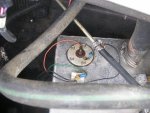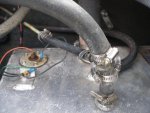PRW
Cadet
- Joined
- Oct 22, 2009
- Messages
- 24
Looking for some opinions/guidance. I think I have it sorted out but I just wanted to run it by the experts real quick.
I have a 1985 Baja Sunsport 190 with a built 305. I've only had the boat a few months so most of my boating time has been spent fixing shoddy workmanship and lack of maintenance.
The previous owner has fitted the boat with Mallory Marine fuel injection. It runs and runs good but there are a lot of issues that need addressed for safety etc.
In order to run the fuel injection return line to the tank he has fabricated some kind of T-fitting that he spliced into the fuel tank vent line. It works but I know it's not correct and more importantly it has a tendancy to leak a slight bit of fuel during use. Big time no-go. I've attached some pictures of the wonderful work just as a reference.
Just so happens my fuel gauge sending unit is leaking and needs replaced as well. While searching the internet I found a sending unit that also includes a return line fitting. I'm pretty much set on buying this unit but I wanted to make sure there weren't any other options out there before I bought this one.
Here's what I'm looking at (disclaimer , I did not see this for sale on iboats or I would be linking to it)
http://www.amazon.com/Moeller-Marine-Electric-Sending-Diesel/dp/B000MTI15U
I have a 1985 Baja Sunsport 190 with a built 305. I've only had the boat a few months so most of my boating time has been spent fixing shoddy workmanship and lack of maintenance.
The previous owner has fitted the boat with Mallory Marine fuel injection. It runs and runs good but there are a lot of issues that need addressed for safety etc.
In order to run the fuel injection return line to the tank he has fabricated some kind of T-fitting that he spliced into the fuel tank vent line. It works but I know it's not correct and more importantly it has a tendancy to leak a slight bit of fuel during use. Big time no-go. I've attached some pictures of the wonderful work just as a reference.
Just so happens my fuel gauge sending unit is leaking and needs replaced as well. While searching the internet I found a sending unit that also includes a return line fitting. I'm pretty much set on buying this unit but I wanted to make sure there weren't any other options out there before I bought this one.
Here's what I'm looking at (disclaimer , I did not see this for sale on iboats or I would be linking to it)
http://www.amazon.com/Moeller-Marine-Electric-Sending-Diesel/dp/B000MTI15U






















